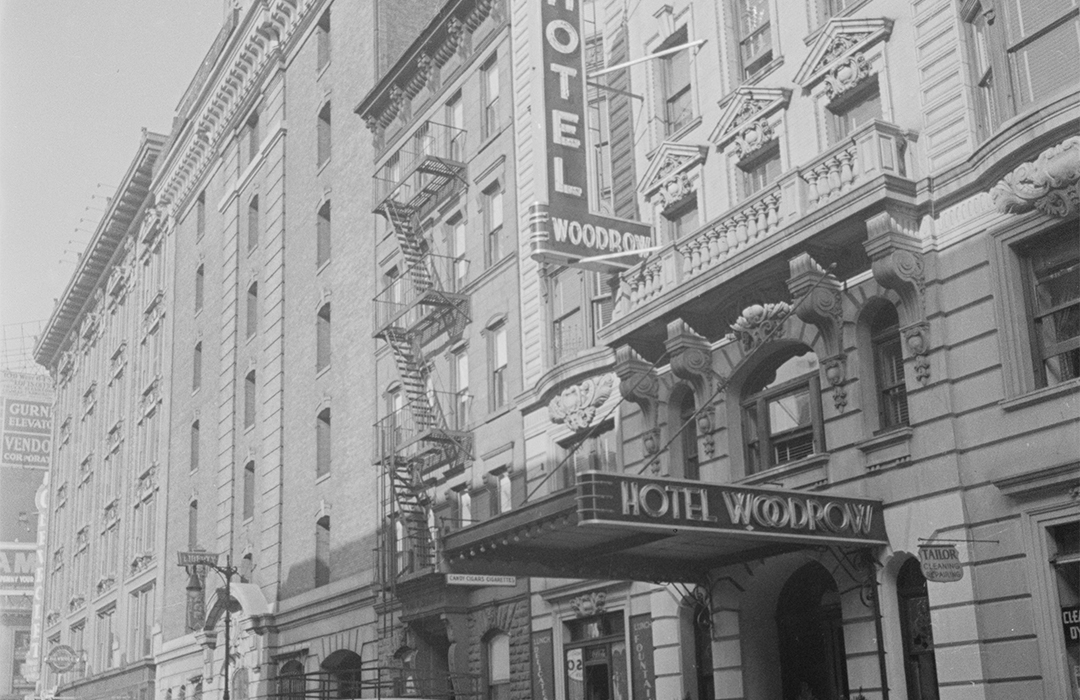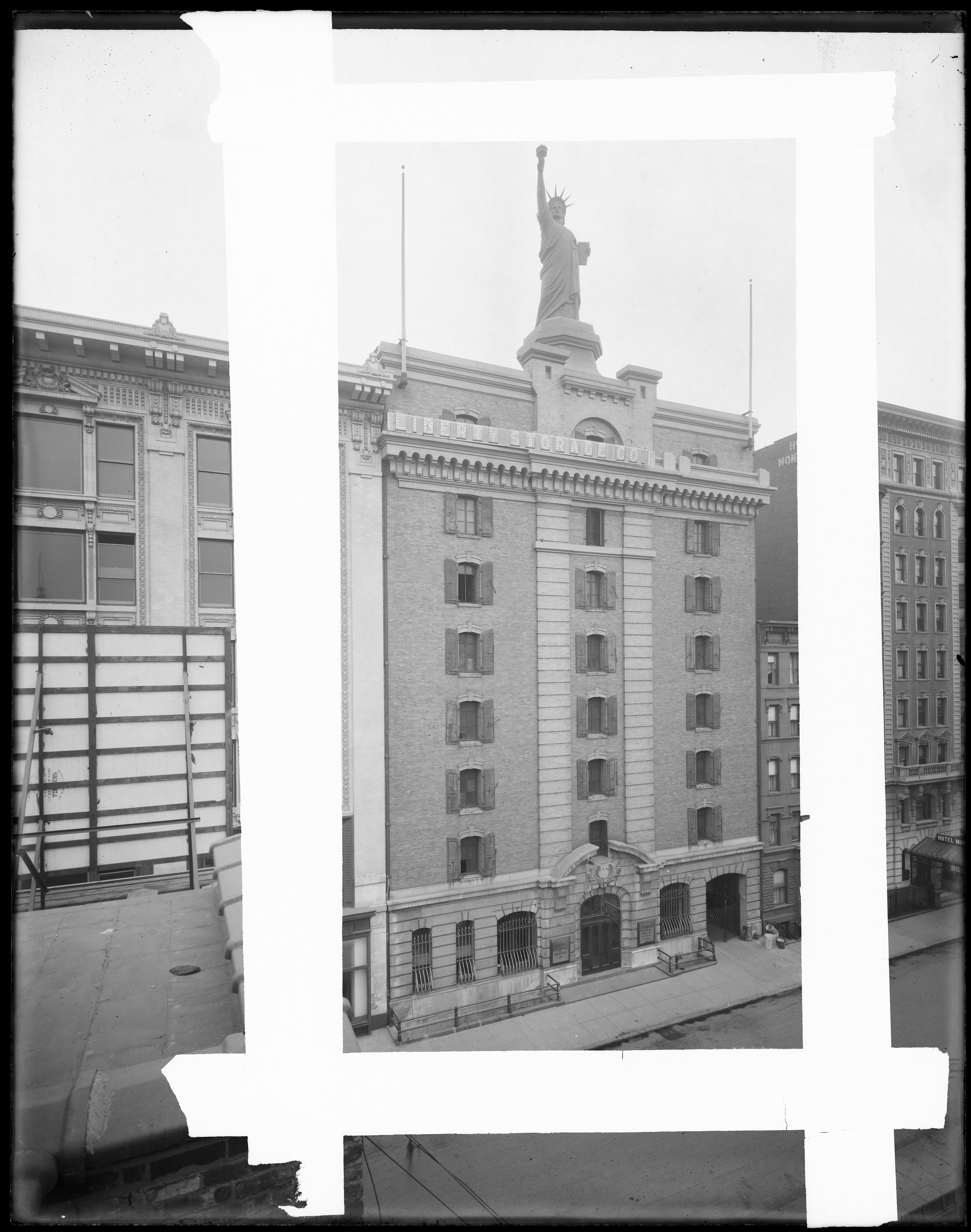
The Liberty Storage Warehouse
by Tom Miller
Real estate developer Charles M. Rosenthal purchased the 75-foot-wide parcel on the north side of West 64th Street, just east of Broadway, in July 1901. The Record & Guide noted that he “will erect thereon a 10-story fireproof storage warehouse.” Even before he bought the land, Rosenthal had sold the property, including the proposed warehouse, to the Liberty Storage Warehouse. He put architect Benjamin W. Levitan in charge of designing the structure.
The warehouse was completed in 1902 at a cost of $325,000 to construct—a significant $10.7 million by 2022 standards. The relatively unadorned, six-story brick midsection sat upon a one-story rusticated limestone base. Here the elliptically arched entrance sat within an elliptical arch, crowned with a carved cartouche within a dramatic broken pediment. The top floor, which sat behind a stone railing atop an ambitious corbel table, took on a castle-like look with two faux towers that flanked a large arched window. And perched above it all was a 40-foot tall painted tin replica of the Statue of Liberty, the symbol of the Liberty Storage Warehouse.
Like today’s moving and storage companies, Liberty Storage Warehouse rented vaults and rooms for long- and short-term storage of furniture and valuables. There were safety deposit boxes, jewelry safes, and silver vaults available. The firm also operated a fleet of trucks for moving purposes.
In 1907 at least one of the safety deposit boxes was not used for safely storing family jewels or heirlooms, but stolen cash. On June 29 that year Chester B. Runyan stole $96,000 from the Windsor Trust Co. He hid out in the apartment of a former prostitute, Laura Carter, alias Laura Ison, at 619 West 144th Street. The two met on the street one night, and after that Runyan rarely went home to his wife.
The Sun described her as “a gross looking woman of middle age.”
Laura Carter was as shady as her bank robber friend. The Sun described her as “a gross looking woman of middle age.” For a week the money was kept in a suitcase in the bedroom. But it did not take long for Laura to begin extorting money from Runyan. Finally, as worded by The Sun, she “betrayed him.”
When Runyan was arrested, almost all the cash was recovered other than $25,000. Runyan explained that he had paid Carter $5,000 to hide him. Then, reported The Sun, “when she had threatened to expose him, he gave her $10,000 more in two installments. Then, he says, she stole $10,000.” Laura Carter was questioned at length. She scoffed at the suggestion the pair were lovers and called him “the old gazabo who pays the bills.”
Laura had a safety deposit box at the Liberty Storage Warehouse under another alias, Laura Bayne. (The Sun later explained, “That is one of the many names she went under in the Tenderloin [District]. She had the vault some time before she met Runyan on June 18, before he stole the money.) Detectives went to the Liberty Storage Warehouse with a locksmith and opened Laura’s safe deposit box. But they were too late. It was empty and employees there told them Laura had been there two days earlier.
The business of the Liberty Storage Warehouse was highly successful. In 1911 the firm purchased the lots at 48 and 50 West 65th Street, directly behind, as the site of a nine-story addition to the building. The Evening Post reported, “The improvement, including the cost of land, involves about $250,000.”
The company modernized its fleet in 1913 by replacing horse-drawn trucks with motorized moving vans. On April 5, The Troy Times reported, “Recently this company delivered by Alco truck a load of household furniture to Huntington, L. I., and returned to the warehouse inside of ten hours, covering a distance of eighty-seven miles…When horses were used on such work the arrival at Huntington was made during the evening of the first day and another day was required for the return trip to New York.”
Prohibition was enacted in January 1920, and while it prohibited the sale or manufacture of liquor, it could not outlaw the ownership of alcohol that had already been purchased by private citizens. Therefore, individuals who could afford to do so filled their wine cellars and liquor cabinets before the law went into effect and enjoyed their stash for as long as it held out. Not surprisingly, when the homes of the wealthy were burglarized, liquor and wine were among the first things to be hauled off.
Secure locations like the Liberty Storage Warehouse were perfect for safeguarding caches of Prohibition Era liquor. One client, however, was most definitely not merely a private citizen. A mobster gang had stored 200 cases of contraband rye whisky there, valued at $16,000. It was a situation that did not escape the attention of other gangland figures.
Late on a winter’s night in 1923, the night watchman received a call from the warehouse director. He said he had left a package in his office, that his secretary was coming to the building, and to please let him in when he rang. The watchman went looking for the package, which had been described in detail, but he could not find it. When the doorbell rang, the watchman opened it for a man who identified himself as Mr. Wood’s assistant.
“Have you got the package?” he asked.
The watchman confessed he could not find it, and told the man he should probably look for it himself. As he opened the door wider, three other men rushed in, and tied and bound him. According to Graham Nown in his 2013 Arkansas Godfather, The Story of Owney Madden and How He Hijacked Middle America, “The watchman had been tied loosely enough so that he could free himself, and he raised the alarm.” Owney Madden and his two accomplices were captured the following day.
[Prohibition] could not outlaw the ownership of alcohol that had already been purchased by private citizens.
In 1942 the Government initiated the Scrap Drives, during which time all manner of metal objects—from tin cans to copper eaves and downspouts—were donated to the war effort. At least one person eyed the statue atop the Liberty Storage Warehouse Building for the cause. On February 15, 1943, an article in the Barnard Bulletin said, “if you’ve never got around to seeing the Statue of Liberty, stay on the East side of the trolley car and watch out for it around the sixties. On top of the Liberty Storage Warehouse building, there’s a Miss Liberty Junior which is almost as good as the real thing, torch and all. Hurry up, though, before they hand her over to the scrap drive.”
Exactly four decades later, in July 1983 as the original Statue of Liberty was about to receive a $40 million restoration, the superintendent of Liberty Island, David Moffitt, conceded to Newsday that he “is aware that his monument has a rival on top of the eight-story Liberty warehouse at 43 W. 64th st.” But, said the article, his enthusiasm “is quite restrained.” Moffitt pointed out to the journalist the warehouse statue is “a rendition, not a replica, because it’s out of proportion, and the folds in its cloth don’t correspond at all.”
At the time of that article, The Ginger Man bar-restaurant was next door to the Liberty Storage Warehouse Building. After going through bankruptcy, the restaurant was renamed O’Neals in 1994. The ground floor of the Liberty Storage Warehouse Building was renovated as its new home.
In 2001 the Athena Group purchased the building and initiated a $44.25 million conversion to residential use. Despite the proposed name of the luxury apartment building, Liberty Lofts, the new owners had no use for the tin statue on the roof. After some negotiations, it was finally moved to the Brooklyn Museum of Art’s Steinberg Family Sculpture Garden.
Tom Miller is a social historian and blogger at daytoninmanhattan.blogspot.com



